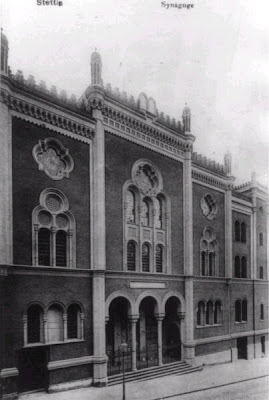On this trip, she had hoped especially to see Rosengarten, a street near the harbor where she was born (in 1933) and where she visited family many times.
Yesterday, our tour guide, an elderly Pole, seemed to have no idea what "Rosengarten" referred to, which is entirely understandable, since 65% of the city was destroyed, and virtually the entire German population either fled (in some instances, twice), was killed, or died of starvation. Under the direction of the Soviets, the city was repopulated with people from central Poland—and many Ukrainians and Poles who had been forced out of their homelands by the Soviets.
After the war, there was an active program to eliminate all traces of German culture in Szczecin. In recent years, however, the city has tried to restore the grandeur and culture that once was: the churches, the parks, the public buildings, etc.
* * * * *
After a little detective work, I discovered that Rosengarten Straße is now known as Podgórna Street. So, today, we visited it. We found that many of the structures of little Rosengarten Straße had been destroyed—or have been otherwise eliminated—though we did find several surviving structures. (See pics.)My mother said that she has always had a strong sense of what Rosengarten looked and felt like—"like those movie scenes of old New York, with the tall narrow buildings, narrow streets, and shops and delicatessens and endless hectic activity," she says. It was a small, steep street. A special street.
"It was a little run down and somewhat poor; it was largely a Jewish neighborhood with many small Jewish businesses, and it was a real community."
She loved it.
Today, after walking up and down the little street for ten or fifteen minutes, she decided that there was no doubt that Podgórna was indeed Rosengarten. She remembered her family's old address and she seemed to find that, more or less. Still, the surviving buildings had changed dramatically. And there were new buildings that were nothing like the old ones.
And the people—well, they really have no connection at all to anyone who lived here 66 or 70 years ago. Those people are all gone, owing to one horror or another.
And there's no trace of them here.
Looking up to the top of Rosengarten; there are two churches nearby
A shop halfway up Rosengarten Straße; that's mom in the doorway
As the street descends toward the harbor, it becomes darker, dingier. It seems to peter out into nothing
Nearby: a plaque on a wall where a synagogue once stood. It is obscure, hard to get to
A little closer.
Before Kristallnacht: Stettin synagogue













1 comment:
Nice writing here--especially that first sentence, BvT. How sad, intriguing, frustrating, weird it must be for your Mom to find the place so (almost) unrecognizable.
MAH
Post a Comment